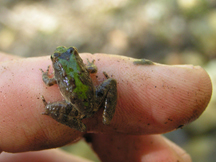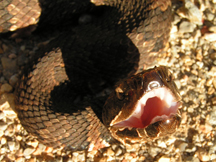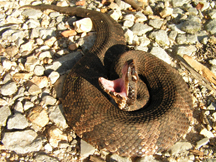
4-08-04
Trip Details
Location: Union County, Illinois.
Herpers: Jeff LeClere, Jim Scharosch & Matt Ricklefs
Start Time: 7:00 am
Weather: Mostly sunny. Low wind. High of about 70 degrees.
Quote of the day: “Uhh there’s somethun!”
As usual, when planning a herp trip the weather is always a gamble. As the months and weeks grew closer, we went from leaving at 3:00 pm Thursday to having Jeff come down on Wednesday night and us leaving at 7:00 am And so it was, Jeff made the long trip down from Minnesota Wednesday night and we left bright and early Thursday morning. Our destination was a historic herp location – Snake Road. The trip down is a long one and we reached our location at about 3:00 pm The weather also cooperated well and besides the change in temperature coming this far south, the conditions remained conductive to snake hunting. Jim and I also planned to make a new acquaintance, Mike Pingleton. Jeff knew Mike, and Jim and I were anxious to meet him as we have enjoyed his web site. Besides, any time you can meet someone with the same passion of herping, it’s a good thing. Mike was unable to meet us on this day and we would need to delay our meeting until Friday. We were also anxious to get out and herp so off we went!
Jeff and I were familiar with the road, but it had been about ten years since I had been down. Jim and I relied on Jeff’s expertise of the area as he has spent time in recent years down here. So at 3:00 pm we started our journey down the road. One of our main targets was the Cottonmouth. Jim and I had not found these I the wild (Jeff has found about everything…) and we were excited to find our quarry. Low and behold, our first catch of the day was a Western Cottonmouth (Agkistrodon piscivorus leucostoma).
Water Moccasin tends to be misleading and I think just about everywhere there are water snakes, there are reports of “poisonous water moccasins”. Iowa is significantly out of the range of the Western Cottonmouth, the most northern ranging of the Cottonmouths, but we have many arguments throughout the year with people claiming Iowa has poisonous water snakes, water moccasins, or any other name that might be imagined. Many times people are adamant and the argument is a lost cause. But this day we truly had a Cottonmouth. It was a juvenile one, about nine inches long, but still it was a bona fide Cottonmouth. This one was found in a pile of leaves, tucked neatly away. It made no motion when found and we took the opportunity to take some pictures before looking at this one a little closer. We took it out of it’s hiding place to get a closer look at its patterning and its distinctive yellow tail. The young, like copperheads, use their tails to lure prey close. It’s a behavior known as caudal luring. Cottonmouths have more yellow tails usually and copperheads usually have more greenish tails. This color is usually lost when the snake becomes mature, but it can at times last to adulthood. I use the term usually a lot here, but when you think something can’t happen it usually can. You will see this shown later on…
After a few pictures of the cottonmouth, we let it go back to its hiding place and moved on. We did not find anything for a little while, when Jeff announced he had found the next herp, an Eastern Zigzag Salamander (Plethodon d. dorsalis).
This was an adult, about three inches long. Jeff was very familiar with this species, but Jim and I had little experience with these and many of the salamanders of the area. It was a great find, but we were soon to see that this was a common species in the area. This was found under some wood debris. These have a very peculiar “hopping” motion in trying to escape that was very cool and quite comical. Also pretty effective as if you are not careful, they will easily hop right out of your hand. After more pics, we continued our search. Already a good day! Blanchard’s Cricket Frogs (Acris crepitans blanchardi) are also common in the area and we were to find many color “phases”. One very cool phase has a high green content, know as the “Shawnee phase” as relayed to us by Mike the following day.
We were soon to find that this is a term we would hear a lot. Color phases are often identified to a specific area, and this area around the Shawnee National Forrest is no exception. This is also an area of integration of some species, so this adds to the variance in color phases and patterns. Around this time I was split up from Jeff and Jim and while finding cricket frogs and zigzags, they were finding many other species of salamanders in a spring fed creek. Among the species were Northern Slimy Salamanders (Plethodon glutinosus),
Longtail/Dark-sided Salamanders (Eurycea longicauda x melanopleura – these intergrade in the area),
and some larval salamanders that we were not able to identify.
I did manage to find some more zigzags, as did they.
Some of these salamanders can be very small and we found some that were scarcely over an inch long. When looking for these you need to look closely. I found one and took some video, then when I returned it to it’s hiding place, it displaced another one right there and I didn’t even see that one. After a little while you sharpen your eyes though.
This is a good time to mention the habitat. It is quite unique. Along the length of the approximately three miles of road you have high bluffs on one side and lowland and swamp on the other. This provides an excellent mix for the varied herp species that occur in this area. Due to this unique mix in the spring and fall there is a mass exodus to and from the hibernaculums. Back some thirty years ago it was decided to close this road off to help protect the herps crossing the road and in April and October the road is closed. This alone is very unique as not many places put such a value on herp life. The area is also a smorgasbord of other mammal, fish, bird, plant and insect life and any specialist or naturalist can have a great time down here.
We soon joined back together. It was getting later, and we knew we only had a few hours left in the day. We traveled almost to the end of the road and decided to head back. On the way back I spotted a snake out on a lily pad. With the angle of the sun, I could not make out the markings, but decided to try for it with my tongs. Sure enough, it was our second cottonmouth of the day. In the process of catching this one I was standing by an old rotted out tree stump. Jeff peeked inside and scored out third cottonmouth of the day also!
Mine was another juvenile, about the same size of the first one, but with a bit more yellow on the tail. Jeff’s was a sub-adult about fifteen inches long.
It had no yellow at this point. There are a few distinctive habits or behaviors of the cottonmouth that also help differentiate it from non-poisonous water snakes. Cottonmouths do obviously have the behavior of standing their ground and gapping their mouth to show the white/pink inside, thus the name cottonmouth. They do this from birth. They also often times do not flee as quickly as water snakes. The one on the lily pad was about five feet out from the bank, and it allowed me to get close enough to grab it with my snake tongs. They also tend to carry their heads up in moving and at rest. This can be used to help identify from a distance, but should not be taken for granted. You would never want to grab anything without the aid of a hook or snake tongs if you did not have a certain ID of the animal in question. This is a good time to mention also that venomous snakes are dangerous and can be unpredictable. If you have not had experience and training in catching them, you are better to leave them alone and enjoy them from a distance. Cottonmouths are usually described as “drab” and they are not as colorful as other snakes, but that does not mean they do not have their own beauty, especially as juveniles when their colors and pattern are more pronounced. The have a very distinctive blend of walnut and chestnut browns and light markings around the face. As adults they do tend to get more dark grey to black above, but retain some of the markings on the face. They have unique eyes that have dark brown to black on the bottom and a yellow crescent on the top. Cottonmouths, as do many other snakes, will “rattle” and/or wiggle their tails to make a distracting noise and movement. This can help them escape if a predator was to attack this end and bite it off and allow the “better half” to get a way. It could also be mistaken for an actual rattlesnake. Many people not aware of this behavior have certainly been fooled into thinking that non-poisonous snakes are rattlesnakes, so you can say it does work. Unfortunately many are killed by this misidentification. After the normal allotment of pictures and video, we allowed these two to go back to their hiding places.
We were getting tired and hadn’t seen much on the road where we were. After many misidentified “stick snakes” I finally saw something that did not look like a stick so much. So I announced, “Uhh, there’s something” in a moment of tired stupor. The something was a Ringneck Snake (Diadophis punctatus)
This location is a crossroad for Prairie (P.p. arnyi), Northern (P.p. edwardsii) and Southern (P.p. punctatus) Ringnecks, so the ID is a mix. The ones we were finding tended to have uniform yellow/orange bellies with varied degrees of black spotting. This one was good sized, about thirteen inches long. Of course for the rest of the trip Jeff and Jim had a good time of saying “Uhh there’s somethun!” when we found anything. Which of course was shared with Mike. Ah, to have friends like these!
A little further down and crossing from a small marshy area was our fourth cottonmouth. This one was about seventeen inches long.
It had duckweed from the marsh on it and still had not had much to eat since emergence from hibernation. It was very skinny as you can see the fold of skin on the sides especially toward the tail in the photo. You could tell the habit of holding its head up as the body was still wet, but the head was dry. It was not in bad shape, but skinnier than the ones found so far. We were sure it would not be skinny for long as there is plenty for it to eat. This was the last catch of the day.























